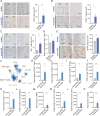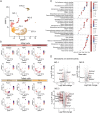Neuroinflammation causes mitral cell dysfunction and olfactory impairment in a multiple sclerosis model
- PMID: 40057769
- PMCID: PMC11889885
- DOI: 10.1186/s12974-025-03388-5
Neuroinflammation causes mitral cell dysfunction and olfactory impairment in a multiple sclerosis model
Abstract
Background: Olfactory dysfunction is an underestimated symptom in multiple sclerosis (MS). Here, we examined the pathogenic mechanisms underlying inflammation-induced dysfunction of the olfactory bulb using the animal model of MS, experimental autoimmune encephalomyelitis (EAE).
Results: Reduced olfactory function in EAE was associated with the degeneration of short-axon neurons, immature neurons, and both mitral and tufted cells, along with their synaptic interactions and axonal repertoire. To dissect the mechanisms underlying the susceptibility of mitral cells, the main projection neurons of the olfactory bulb, we profiled their responses to neuroinflammation by single-nucleus RNA sequencing followed by functional validation. Neuroinflammation resulted in the induction of potassium channel transcripts in mitral cells, which was reflected in increased halothane-induced outward currents of these cells, likely contributing to the impaired olfaction in EAE animals.
Conclusion: This study reveals the crucial role of mitral cells and their potassium channel activity in the olfactory bulb during EAE, thereby enhancing our understanding of neuroinflammation-induced neurodegeneration in MS.
Keywords: Experimental autoimmune encephalomyelitis; Mitral cells; Monoatomic ion channel activity; Multiple sclerosis; Neuroinflammation; Olfactory bulb; Potassium channels; Single-nucleus RNA sequencing; TASK-2.
© 2025. The Author(s).
Conflict of interest statement
Declarations. Ethics approval and consent to participate: Not applicable. Consent for publication: Not applicable. Competing interests: The authors declare no competing interests.
Figures







References
-
- Dendrou CA, Fugger L, Friese MA. Immunopathology of multiple sclerosis. Nat Rev Immunol. 2015;2015(15):545–58. - PubMed
-
- Goverover Y, Chen MH, Costa SL, Chiaravalloti ND, DeLuca J. Smell as a clinical-marker for functional limitations in multiple sclerosis: a pilot study. Mult Scler Relat Disord. 2020;46: 102508. - PubMed
-
- Croy I, Nordin S, Hummel T. Olfactory disorders and quality of life–an updated review. Chem Senses. 2014;39:185–94. - PubMed
-
- Yang L, Li LM, Yang LN, Zhang LJ, Fu Y, Li T, et al. Olfactory dysfunction in patients with multiple sclerosis. J Neurol Sci. 2016;365:34–9. - PubMed
MeSH terms
Grants and funding
LinkOut - more resources
Full Text Sources
Medical
Molecular Biology Databases

